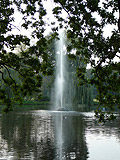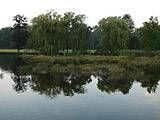Černý Causes Havoc by an Ironic Euro-Mosaic
Jan 20, 16:04 Filed under news
Entropa: an installation by David Černý at the European Council building, is yet about to be set in motion, but it’s filling headlines already. Černý based his work on stereotypes about European states. Romania is “defined” by Dracula, France seems to be on strike and so on. The CR’s frame is a display of quotes of Vaclav Klaus. So far so acceptable.
Denmark is made of Lego and resembles the Prophet Muhammad caricature, which led to massive protests a few years ago. In this case he is sort of reviving a wound not yet healed. But it’s not demeaning.
The Germans are criss-crossed by highways, which seem to form a kind of Swastika. That’s cruel, but it’s also witty enough and, well, the Germans are used to it. During previous decades they grew very patient and humble about their history and the constant (and rightful) reminding of the Nazi period is a part of their contemporary European experience. So, in fact this fulfills the concept perfectly.
The frame of Bulgaria is filled with a Turkish toilet. Little wonder the Bulgarian officials are infuriated: are we supposed to be represented by a toilet? Is that all we are to be known for?
Definitely not- and that’s the point. It’s all stupid stereotypes, that’s exactly what the installation is about. The question remains whether this is really the best way to express this thought- which is, after all, quite banal.
Černý is well known here for rejecting the notion of Czech patriotism and “national identity”- he describes a typical Czech as a fat, brute, beer-loving coward who spends his free time watching other people playing football. He doesn’t have strong sentiments about our glorious past either: one of his famous works in the statue of St Wenceslas in the Lucerna passage. The statue is a copy of the one on Wenceslas square, only here the horse is turned upside down. The horse looks like dead meat and the Czech patron looks ridiculous as he maintains the same heroic pose while sitting on a corpse.
Among many other works, Černý also made the black babies crawling the Zizkov TV tower. Less provocative, quite nice I’d say. His third (the earliest, actually) most well-known work was the tank on Klárov. For many years it was a memorial of the Russian army on the square by the Malostranská Metro station. Černý, a student at the time, gave it a pink coating.
The tank was an answer to 20 years of Soviet propaganda. On the other hand, it was a memorial for the dead Russian soldiers who liberated most of the Czechoslovakia in 1945. We all know what followed and the memorial was part of the post- 1968 propaganda, but the soldiers really died here, thousands of them. For many Czechs this was too much: it seemed not only to reject the occupation and the Sovietization of our past, but also to ignore, or ridicule, the sacrifice of the individual Russian soldiers.
This sort of brings us back to Entropa. It is, again, a concept that is both understandable and questionable. Sometimes it is necessary to be annoying, but sometimes it can just be counter- productive, self- conscious and elitist. The dividing line is almost invisible.
What we should not forget, while forming an opinion on the mosaic, is whether it’s really good- it should not be made a 100% political case.
All reservations aside, it seems almost redundant to add that it, of course, should NOT be taken down or changed. If Černý now bowed down and gave the Bulgarians some “nicer” stereotype, he would completely ruin the concept- there are no “good” stereotypes, we should, as we’re in the Union, try to liberate ourselves from all of them.
 The Czech Constitutional Court has just decided that the Treaty of Lisbon does not collide with the Czech constitution. That means it can be ratified either by parliament, or by referendum. The latter option is not very likely at this moment, since all the major political actors, except the Communists, are in favour of the parliamentary way.
The Czech Constitutional Court has just decided that the Treaty of Lisbon does not collide with the Czech constitution. That means it can be ratified either by parliament, or by referendum. The latter option is not very likely at this moment, since all the major political actors, except the Communists, are in favour of the parliamentary way.  The following events are quite familiar. Every year politicians and various demonstrators gather in Prague and elsewhere. Apart from the official act, this year we see an anti- radar base demonstration and a demonstration for some corrections of the Czech political scene: notably decrease in the influence of lobbyists, an end to the MPs’ legal immunity and some other points. There are also some smaller actions taking place around the November 17. Last week it was a series of documentaries and debates, depicting the economic transformation and emergence of today’s political situation mostly in dark colors. The event was co- organized by the same organizations that participate on the mention demo for corrections in the Czech political system.
The following events are quite familiar. Every year politicians and various demonstrators gather in Prague and elsewhere. Apart from the official act, this year we see an anti- radar base demonstration and a demonstration for some corrections of the Czech political scene: notably decrease in the influence of lobbyists, an end to the MPs’ legal immunity and some other points. There are also some smaller actions taking place around the November 17. Last week it was a series of documentaries and debates, depicting the economic transformation and emergence of today’s political situation mostly in dark colors. The event was co- organized by the same organizations that participate on the mention demo for corrections in the Czech political system.  It’s possible that safety standards inside the building were not met. Little Hanoi is said to have been quite isolated and the suspicion is there. Also, the fire bothered many people nearby, the operation cost millions and it was potentially dangerous to other objects. These points are likely to add to the reserved attitude of Czechs towards the Vietnamese minority in CR. The relationship is not actually bad, Czechs often admire the Vietnamese shopkeepers’ determination and ability, after all, they’re working hard, but the Czech attitude is still quite patronizing and often suspicious. There is a stereotype of every Vietnamese being an uneducated shopkeeper and of their goods being faulty and often fraudulent. Any case like this one may add to the suspicions and latent xenophobia that may sometimes be seen in the Czech public. While stereotype- breaking examples are scarce and little accented by the media, images of a Vietnamese market covering its neighborhood in smoke, is not welcome.
It’s possible that safety standards inside the building were not met. Little Hanoi is said to have been quite isolated and the suspicion is there. Also, the fire bothered many people nearby, the operation cost millions and it was potentially dangerous to other objects. These points are likely to add to the reserved attitude of Czechs towards the Vietnamese minority in CR. The relationship is not actually bad, Czechs often admire the Vietnamese shopkeepers’ determination and ability, after all, they’re working hard, but the Czech attitude is still quite patronizing and often suspicious. There is a stereotype of every Vietnamese being an uneducated shopkeeper and of their goods being faulty and often fraudulent. Any case like this one may add to the suspicions and latent xenophobia that may sometimes be seen in the Czech public. While stereotype- breaking examples are scarce and little accented by the media, images of a Vietnamese market covering its neighborhood in smoke, is not welcome. 

 The original Old Town City Hall was severely damaged at the end of WWII, after it became a target of the German occupation army during the Prague Uprising in May 1945. It was set on fire and had to be taken down. Since then, plans for a new building were in motion.
The original Old Town City Hall was severely damaged at the end of WWII, after it became a target of the German occupation army during the Prague Uprising in May 1945. It was set on fire and had to be taken down. Since then, plans for a new building were in motion. One of the most remembered projects is the one by Josef Gočár form the 1909 competition. The modernist seems to have allowed his fantasy a free way and suggested a pyramid- like monument inspired by cubism, in a style that might have inspired some later art deco architecture. The project is interesting to have a look at and it is likely it was meant rather as an intriguing idea than something likely to be constructed. It would be enormously expensive and it just couldn’t fit the surroundings- it might look appropriate somewhere near The Chrysler Building, not
One of the most remembered projects is the one by Josef Gočár form the 1909 competition. The modernist seems to have allowed his fantasy a free way and suggested a pyramid- like monument inspired by cubism, in a style that might have inspired some later art deco architecture. The project is interesting to have a look at and it is likely it was meant rather as an intriguing idea than something likely to be constructed. It would be enormously expensive and it just couldn’t fit the surroundings- it might look appropriate somewhere near The Chrysler Building, not  Since the fifties, there were several very ugly propagandist projects, for example a wall, which would serve for film projections during major manifestations and some undignified attempts for something resembling the Kotva mall on Náměstí Republiky.
Since the fifties, there were several very ugly propagandist projects, for example a wall, which would serve for film projections during major manifestations and some undignified attempts for something resembling the Kotva mall on Náměstí Republiky.